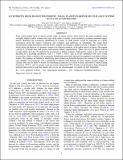ECCENTRICITY FROM TRANSIT PHOTOMETRY: SMALL PLANETS IN KEPLER MULTI-PLANET SYSTEMS HAVE LOW ECCENTRICITIES
Author(s)
Van Eylen, Vincent; Albrecht, Simon
DownloadEylen-2015-ECCENTRICITY from TR.pdf (1.581Mb)
PUBLISHER_POLICY
Publisher Policy
Article is made available in accordance with the publisher's policy and may be subject to US copyright law. Please refer to the publisher's site for terms of use.
Terms of use
Metadata
Show full item recordAbstract
Solar system planets move on almost circular orbits. In strong contrast, many massive gas giant exoplanets travel on highly elliptical orbits, whereas the shape of the orbits of smaller, more terrestrial, exoplanets remained largely elusive. Knowing the eccentricity distribution in systems of small planets would be important as it holds information about the planet's formation and evolution, and influences its habitability. We make these measurements using photometry from the Kepler satellite and utilizing a method relying on Kepler's second law, which relates the duration of a planetary transit to its orbital eccentricity, if the stellar density is known. Our sample consists of 28 bright stars with precise asteroseismic density measurements. These stars host 74 planets with an average radius of 2.6 R[subscript ⊕]. We find that the eccentricity of planets in Kepler multi-planet systems is low and can be described by a Rayleigh distribution with σ = 0.049 ± 0.013. This is in full agreement with solar system eccentricities, but in contrast to the eccentricity distributions previously derived for exoplanets from radial velocity studies. Our findings are helpful in identifying which planets are habitable because the location of the habitable zone depends on eccentricity, and to determine occurrence rates inferred for these planets because planets on circular orbits are less likely to transit. For measuring eccentricity it is crucial to detect and remove Transit Timing Variations (TTVs), and we present some previously unreported TTVs. Finally transit durations help distinguish between false positives and true planets and we use our measurements to confirm six new exoplanets.
Date issued
2015-07Department
MIT Kavli Institute for Astrophysics and Space ResearchJournal
The Astrophysical Journal
Publisher
IOP Publishing
Citation
Van Eylen, Vincent, and Simon Albrecht. “ECCENTRICITY FROM TRANSIT PHOTOMETRY: SMALL PLANETS IN KEPLER MULTI-PLANET SYSTEMS HAVE LOW ECCENTRICITIES.” The Astrophysical Journal 808, no. 2 (July 27, 2015): 126. © 2015 The American Astronomical Society
Version: Final published version
ISSN
1538-4357
0004-637X